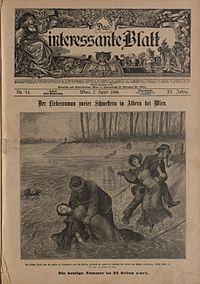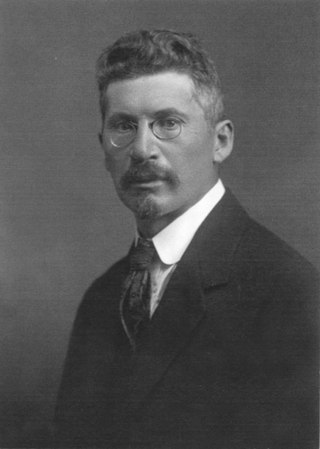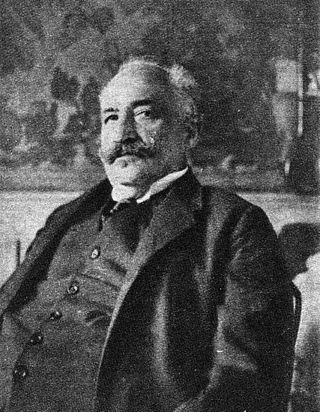
Das Interessante Blatt was an Austrian magazine which appeared weekly from 1882 to 1939. A supplement of the newspaper appeared under the title Wiener Bilder, their successor newspaper was the Wiener Illustrierte. [1] [2] [3]

Das Interessante Blatt was an Austrian magazine which appeared weekly from 1882 to 1939. A supplement of the newspaper appeared under the title Wiener Bilder, their successor newspaper was the Wiener Illustrierte. [1] [2] [3]

The Austrian National Library is the largest library in Austria, with more than 12 million items in its various collections. The library is located in the Neue Burg Wing of the Hofburg in center of Vienna. Since 2005, some of the collections have been relocated within the Baroque structure of the Palais Mollard-Clary. Founded by the Habsburgs, the library was originally called the Imperial Court Library ; the change to the current name occurred in 1920, following the end of the Habsburg Monarchy and the proclamation of the Austrian Republic. The library complex includes four museums, as well as multiple special collections and archives.

Josef Weinheber was an Austrian lyric poet, narrative writer and essayist.
Georg Carl Stetter was an Austrian-German nuclear physicist. Stetter was Director of the Second Physics Institute of the University of Vienna. He was a principal member of the German nuclear energy project, also known as the Uranium Club. In the latter years of World War II, he was also the Director of the Institute for Neutron Research. After the war, he was dismissed from his university positions, and he then became involved in dust protection research. After his dismissal was overturned, he became Director of the First Physics Institute of the University of Vienna, and he began research on aerosols. In 1962, Stetter became a full Member of the Austrian Academy of Sciences. In that same year, the Academy established their Commission for Clean Air, and Stetter served as its chairman until 1985.
AustriaN Newspapers Online (ANNO) is a project run by the Austrian National Library for the conservation of historic newspapers, whereby particularly important and popular newspapers are scanned in and made available on the Internet. By the end of 2009 ANNO had about 4.76 million digitized pages.

Bernhard Wachstein was a Jewish community historian and bibliographer who rebuilt, expanded, and modernized the library of the Israelitische Kultusgemeinde Wien. He also performed important bibliographic work, particularly relating to the history of Austrian Jews.
The Karl Renner Prize, established on the occasion of the Austrian Federal President Karl Renner’s 80th birthday by the city of Vienna, is awarded to individuals or groups in recognition of merits for Vienna and Austria in cultural, social as well as economical concerns, acknowledged on a national or international level. Endowed with 43,600 euro, the prize is currently given to a maximum of six nominees every three years.

Arbeiterwille was social democratic paper published in Graz, Styria, Austria, from 1890 to 1934.
Max Fenichel, also known as Maximilian Fenichel and Menasche Fenichel, was an Austrian photographer.
Richard Groner was an Austrian local historian and journalist.

John Quincy Adams was an Austrian genre and portrait painter of American ancestry.

Ignaz Schnitzer was a journalist, translator, librettist and newspaper founder.

Ludwig Karpath was an Austrian musicologist.
Ignaz Eigner, also Ignác and Ignácz was an Austrian lithographer and painter.

Der Humorist was a journal published from 1837 to 1926 with the title "eine Zeitschrift für Scherz und Ernst, Kunst, Theater, Geselligkeit und Sitte". In the years 1837 to 1848, Der Humorist was published without any further addition. Afterwards with "ein Volksblatt für alle Interessen des Rechts und des Lichts, für Leben und Kunst, für Ernst, Scherz und Satyre, nebst bildlichen, satyrischen Beilagen unter dem Titel: Karikaturen-Album".

Ludwig Speidel was a German writer, which in the second half of the 19th century was the leading music, theater and literary critic in Vienna.

Alexander von Koller was an Austro-Hungarian military officer, who achieved the rank of General of the cavalry and served as Imperial and Royal Minister of War from 1874 to 1876.
Carl Julius Haidvogel was born to Carl Haidvogel and Juliana on 13 September 1891 in Vienna, Austria. From 1912, Haidvogel worked as a registrar for the municipality of Vienna, was a part-time editor at the public educational institute and observatory Urania, and a dramaturge at the Bühne der Jungen. He started publishing his famous literary works in 1918. In the 1920s, he came into contact with the "Weekend and Settlement Movement" of the Viennese municipal Councillor Anton Weber, which also influenced his work. In 1937, Haidvogel joined the "Union of German Writers in Austria". Although Haidvogel was not among the contributors to the Confession Book of the "Union of German Writers of Austria" (BdSÖ), he was one of the signatories of the "Confession of the Union of German Writers to the Führer", published in Grazer Tagespost on 27 March 1938. Haidvogel was friends with Josef Weinheber and Karl Heinrich Waggerl. Haidvogel's work "The Pillars of God" was placed on the list of banned authors and books in Austria in 1946. In 1956, Haidvogel was retired. In 1971, he received the Austrian Decoration for Science and Art. He welcomed his son Gerhard with wife Lotte on 14 January 1921; Gerhard became the famous Austrian architect Gerhard Haidvogel. Carl Julius Haidvogel died on 26 December 1974 in Graz.
The Neues Wiener Tagblatt was a daily newspaper published in Vienna from 1867 to 1945. It was one of the highest-circulation newspapers in Austria before 1938.
Lili Hutterstrasser-Scheidl was an Austrian composer, known by the pseudonym Lio Hans. Her opera Maria von Magdala was performed at the Vienna Volksoper on December 22, 1919, and was the only musical stage work by a female composer to be performed in Austria in the 20th century until Olga Neuwirth's Bählamms Fest in 1999.

Wiener Bilder or Wiener Bilder Illustrated Sunday paper was the illustrated supplement of the Austrian conservative weekly Das interessante Blatt.